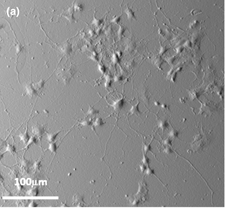No CrossRef data available.
Published online by Cambridge University Press: 05 November 2018

Electrically conducting substrates have shown much promise as neuronal scaffolds and in other biologic and biomedical applications where a smart and electrically interactive material is needed. Most materials that are inherently conducting are not suitable for biomedical applications and lack biocompatibility or biostability. On the other hand, biologically stable and compatible materials must first be manipulated, modified, and treated in order to impart the necessary electrical conductivity to the material. Here, the authors have investigated the response of PC-12 cells to two types of conducting carbon-based aerogels with different surface roughness. Results show that carbon-based aerogels support cell adhesion, proliferation, and neurite extension. The effects of surface roughness have also been investigated.